
Makarska is a town on the Adriatic coastline of Croatia, about 60 km (37 mi) southeast of Split and 140 km (87 mi) northwest of Dubrovnik, in the Split-Dalmatia County.

Tučepi is a small town and municipality in the Split-Dalmatia County of Croatia. It is located on the Adriatic coast of Dalmatia known as Makarska riviera, about 5 km southeast of Makarska, population 1,819 (2021). It is a popular tourist destination thanks to its scenic coastline, its opportunities for sports and its excellent accommodation.

The Archdiocese of Zadar is a Latin Church ecclesiastical territory or archdiocese of the Catholic church in Croatia. The diocese was established in the 3rd century AD and was made an archdiocese by the Pope Anastasius IV in 1154. Today, it is not part of any ecclesiastical province of Croatia, rather it is the only Croatian archdiocese directly subject to the Holy See.
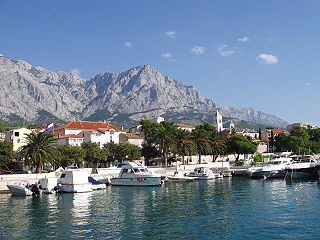
Baška Voda is a village and a municipality in Croatia in the Split-Dalmatia County.

Kozica is a small village in the Split-Dalmatia County of Croatia. It is in the jurisdiction of Vrgorac, 80 km (50 mi) southeast of Split. It is located at the base of the Sveti Mihovil mountain, which is 1,247 m (4,091 ft) high.

The Archdiocese of Split-Makarska is a Latin Metropolitan archdiocese of the Catholic church in Croatia and Montenegro. The diocese was established in the 3rd century AD and was made an archdiocese and metropolitan see in the 10th century. The modern diocese was erected in 1828, when the historical archdiocese of Salona was combined with the Diocese of Makarska. It was elevated as an archdiocese and metropolitan see in 1969, restoring the earlier status of the archdiocese of Split, as it is also known. The diocese was also known as Spalato-Macarsca.
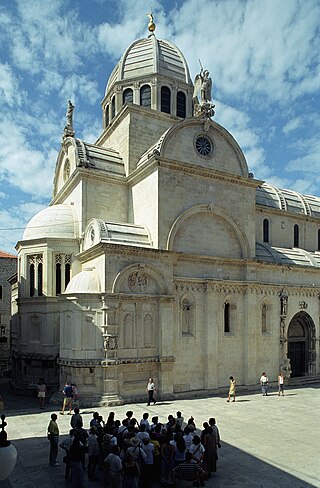
The Diocese of Šibenik is a Latin diocese of the Catholic Church located in the city of Šibenik in the ecclesiastical province of Split-Makarska in Croatia.

The Cathedral of Saint Domnius, known locally as the Sveti Dujam or colloquially Sveti Duje, is the Catholic cathedral in Split, Croatia. The cathedral is the seat of the Archdiocese of Split-Makarska, currently headed by Archbishop Zdenko Križić. The Cathedral of St. Domnius is a complex of a church, formed from an Imperial Roman mausoleum, with a bell tower; strictly the church is dedicated to the Virgin Mary, and the bell tower to Saint Domnius. Together they form the Cathedral of St. Domnius.

The Cathedral of St. Stephen in Hvar is a Roman Catholic cathedral in the city of Hvar, on the island of Hvar in Split-Dalmatia County, Croatia.
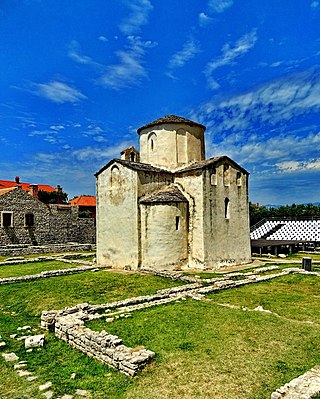
Church of the Holy Cross is a Croatian Pre-Romanesque Catholic church originating from the 9th century in Nin.

Sumartin is a port village in Croatia on the island of Brač. It is the youngest village on the island of Brač and administratively belongs to Municipality of Selca. According to 2011 census, it has a population of 491. Village was founded on 11 November 1646 - the feast day of Saint Martin - by the refugees from the Dalmatian coast and Bosnia and Herzegovina who fled from the Ottomans. It is connected by the D113 highway and by ferry.

Dražen Kutleša is a Croatian prelate of the Catholic Church who became Archbishop of Zagreb in April 2023 after two months as archbishop coadjutor. He was the archbishop of Split-Makarska from 2022 to 2023 after serving as bishop of Poreč and Pula from 2012 to 2020.
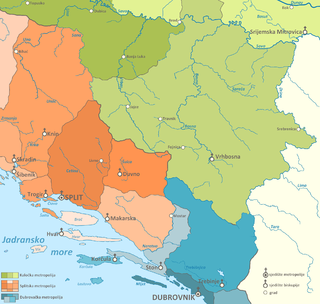
Diocese of Bosnia was a Latin Catholic diocese that existed in Bosnia between the 11th and 15th centuries, and remained formally in existence until 1773.

The Diocese of Duvno was a Latin rite particular church of the Catholic Church that was established in the 14th century with a seat in present-day Tomislavgrad in Bosnia and Herzegovina. It was a suffragan diocese of the Archdiocese of Split, and during the 17th century of the Archdiocese of Dubrovnik. The diocese consisted of four parishes: Roško Polje, Duvno, Posušje and Rama.

Co-cathedral of St. Mark the Evangelist is a baroque church and former cathedral in the Archdiocese of Split-Makarska. It is located in the center of the town of Makarska, Croatia, on Andrija Kačić Miošić Square.

Frane Franić was a prelate of the Catholic Church who served as the Archbishop of Split-Makarska from 1969 until his retirement in 1988. He also served as the last Bishop of Split-Makarska, before the diocese was elevated to the status of an archdiocese, from 1960 to 1969.

Jure Bogdan is a Croatian bishop who serves as 2nd Military ordinary of Croatia since 27 February 2016, had previously served as a rector of Pontifical Croatian College of St. Jerome.

Marin Barišić is a Croatian archbishop. He served as Roman Catholic Archdiocese of Split-Makarska, from 2000 to 2022.
The Diocese of Makarska was a Latin Catholic bishopric from 533 to 590, from 1344 to 1400 and from 1615 until its 1828 merger into the Diocese of Split-Makarska, which preserves its title.
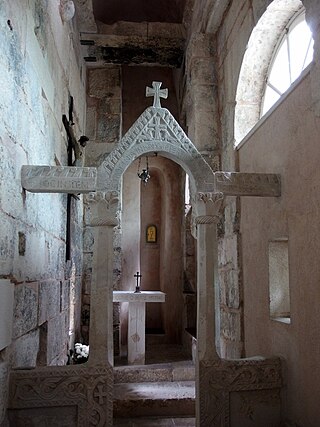
St. Martin's Church is a Roman Catholic church in Split, Croatia. Built into a small space within the ancient Golden Gate of Diocletian's northern wall, it is one of the oldest churches in the city. St. Martin's Church is one of Split's tourist attractions and is known for its fine 11th century chancel screen. It is currently in the care of the Dominican sisters, who have a monastery next door. The church itself is open to public visits.




















